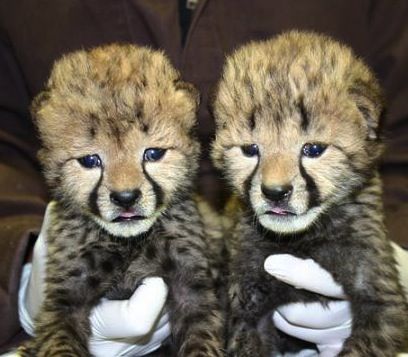
A
pair of cheetah cubs born at the National Zoo in Washington have been
hailed as a miracle, or at least a victory, in the science of breeding
cheetahs. Since they were declared an endangered species, zoos can no
longer import cheetahs from the wild, and breeding them became very
important, not only for the sake of the zoos, but to help researchers
keep them from disappearing altogether. Why are cheetahs so hard to
breed in captivity? SciWrite has a fascinating three-part post on the
history of cheetahs, their social structure in the wild, and the
attempts to breed them in captivity. Oh yeah, and the story of Ally's
difficult birth that resulted in the two cubs, Justin and Carmelita.
From part two:
While some researchers started watching
cheetahs from afar, another group took an opposite approach and
starting collecting blood, urine, and stool samples. Written into the
cheetah’s genes, researchers stumbled upon the cat’s dark history.
Around 10,000 years ago, cheetahs nearly went extinct. An estimated
10-20 individuals survived, the ancestors of all living cheetahs today.
Consequently, current “cheetahs have almost zero percent of genetic
variability,” says Steve Bircher. They are “all like brothers and
sisters.”
Could the lack of genetic diversity having a lingering
effect? Studies of male cheetah sperm showed startlingly low sperm
counts; about one-tenth the normal counts of lions, tigers, and domestic
cats, according to Bircher. This was initially thought to explain low
captive birth rates until it was realized that wild Namibian males with
similarly low sperm counts reproduce just fine.
“Lack of genetic
variability is not what has hampered the cheetah ability to breed,” says
Bircher. “Quite simply, it’s how we managed cheetahs.”
Just above the title of each post the link to the next post in the series.
More
 A
pair of cheetah cubs born at the National Zoo in Washington have been
hailed as a miracle, or at least a victory, in the science of breeding
cheetahs. Since they were declared an endangered species, zoos can no
longer import cheetahs from the wild, and breeding them became very
important, not only for the sake of the zoos, but to help researchers
keep them from disappearing altogether. Why are cheetahs so hard to
breed in captivity? SciWrite has a fascinating three-part post on the
history of cheetahs, their social structure in the wild, and the
attempts to breed them in captivity. Oh yeah, and the story of Ally's
difficult birth that resulted in the two cubs, Justin and Carmelita.
From part two:
A
pair of cheetah cubs born at the National Zoo in Washington have been
hailed as a miracle, or at least a victory, in the science of breeding
cheetahs. Since they were declared an endangered species, zoos can no
longer import cheetahs from the wild, and breeding them became very
important, not only for the sake of the zoos, but to help researchers
keep them from disappearing altogether. Why are cheetahs so hard to
breed in captivity? SciWrite has a fascinating three-part post on the
history of cheetahs, their social structure in the wild, and the
attempts to breed them in captivity. Oh yeah, and the story of Ally's
difficult birth that resulted in the two cubs, Justin and Carmelita.
From part two:
No comments:
Post a Comment